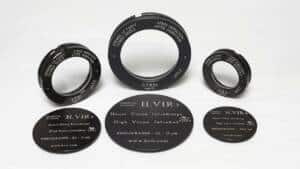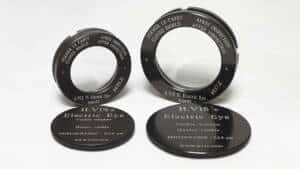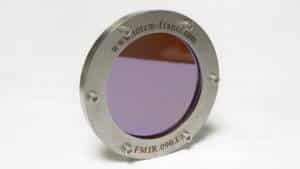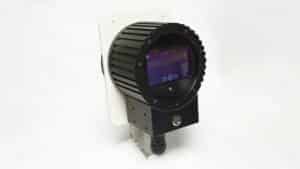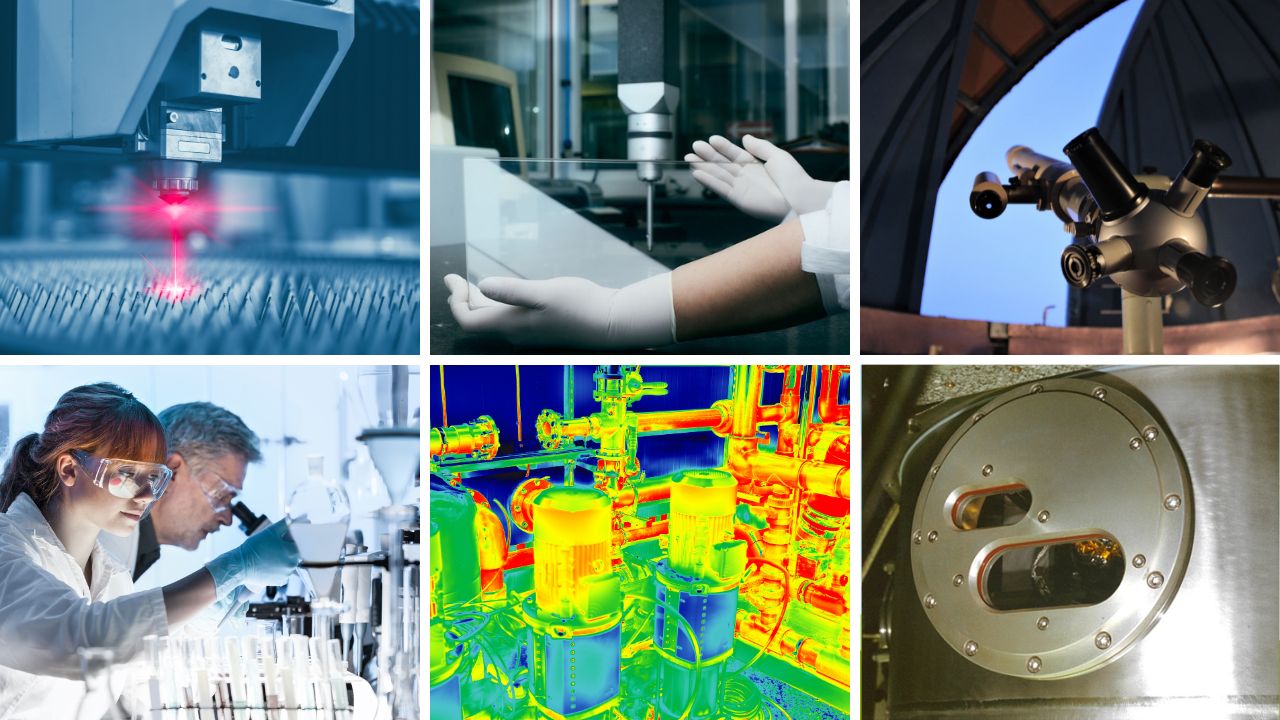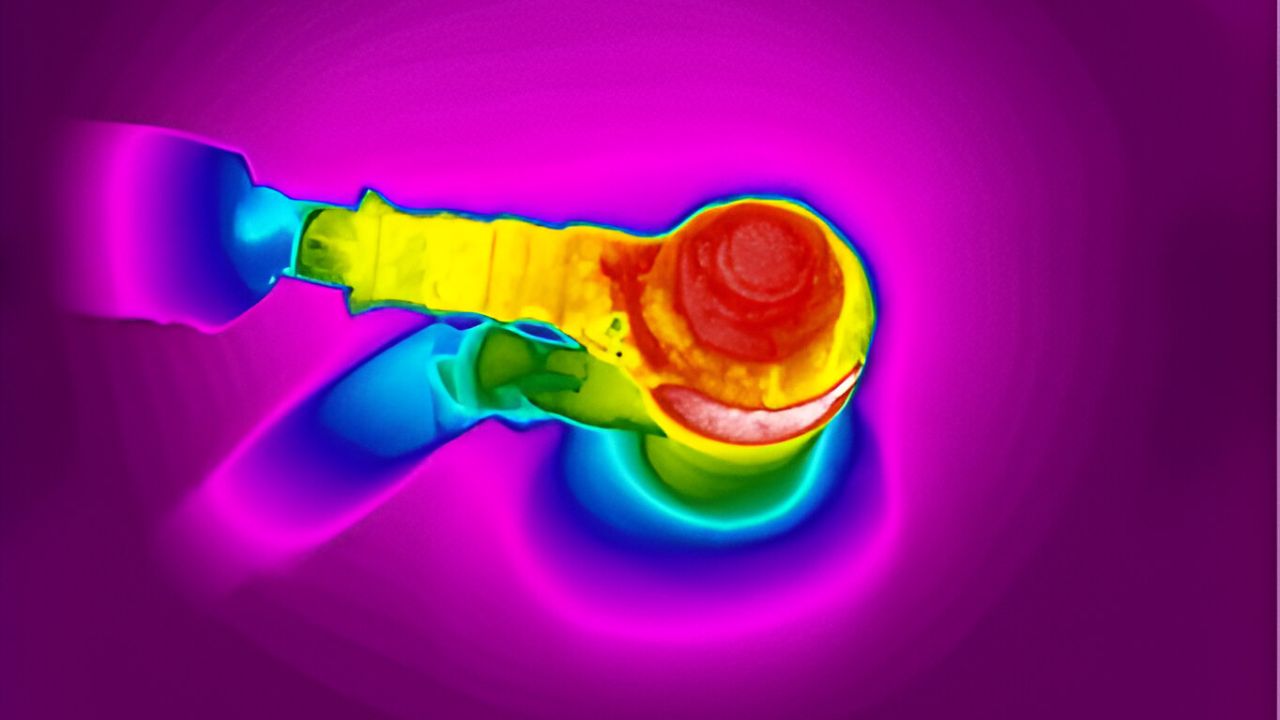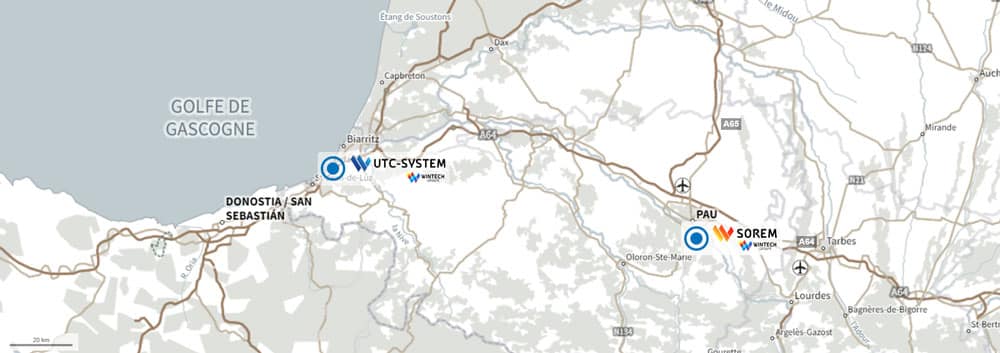Optical Windows: The Most Common Applications by Material
The manufacture of optical windows requires the selection of the right material for the desired use. Optical materials have specific characteristics identified according to criteria such as transmission spectral range, refractive index or Knoop hardness. These criteria help to define the field(s) of application where optical materials perform best. We offer you an overview of the most common areas of application of optical windows depending on the material of manufacture.
- Versatility of N-BK7 optical windows
- Pyrex optical windows for high-temperature, high-pressure observations
- Germanium optical windows for infrared applications
- ZnSe windows for high-power laser optics
- Multispectral ZnS Windows
- Silica Windows for UV and Visible Research
- Quartz windows for versatile UV and visible applications
- BaF2 windows for industrial infrared detection and UV and visible research
- CaF2 windows for multispectral applications
- Sapphire windows for applications in harsh UV and IR environments
Versatility of N-BK7 optical windows
The N-BK7 is used by industry for the protection of cameras and optical sensors in industrial imaging systems and optical dimensional measurement systems (inspection of components at high temperatures or in hostile environments). In research, N-BK7 is used in light microscopy, spectroscopy, and as a protective window. It can also be used to insulate a vacuum chamber. The N-BK7 optical windows are also suitable for use in laser research laboratories and can be used in astronomical instruments to protect optical components (telescopes, cameras).
Pyrex optical windows for high-temperature, high-pressure observations
Pyrex optical windows are often used for industrial furnaces or heat treatment equipment (high-temperature observation). They are also used to monitor chemical reactions in high-temperature, high-pressure reactors. Pyrex optical windows are also used to observe deposition processes in the coatings and vacuum metallization industry. In scientific research, they are used in fluorescence microscopes, chemical research reactors and are used in high-temperature spectrometry instruments. Pyrex windows allow observation of samples under high pressure conditions. Pyrex is used mainly in the visible range.
Germanium optical windows for infrared applications
Due to its wide spectral range in the infrared, germanium is used for the manufacture of optical windows for thermal cameras, night vision and ranging systems (security, military industry). In the field of research, germanium windows are suitable for infrared applications in spectroscopy (study of spectral properties), microscopy (high-resolution imaging of analyzed samples) and astronomy (observation of infrared emissions from stars and planets). Due to the very high reflection loss of this material, it must always be coated with an anti-reflective and/or hard carbon coating (outdoor applications).
ZnSe windows for high-power laser optics
Zinc selenide (ZnSe) optical windows are suitable for infrared optics (short and long waves). ZnSe optical windows are commonly used in high-power laser systems (cutting, welding, laser engraving). Their infrared properties are exploited for applications in thermal imaging (detecting temperature variations), spectroscopy (analysis of infrared spectra of samples), astronomy and astrophysics (on camera detectors to conduct observations). In the defense sector, ZnSe optical windows are equipped with night vision systems, infrared sights and ranging systems.
Multispectral ZnS Windows
Multispectral ZnS optical windows are used in multispectral imaging systems applied to areas such as environmental monitoring (remote sensing instruments), geological mapping or material characterization (property study). Multispectral ZnS portholes are used in spectroscopy and microscopy for sample analysis or biomarker detection. In astronomy, multispectral ZnS optical windows are integrated into the construction of telescopes.
Silica Windows for UV and Visible Research
Fused silica windows are used in imaging systems (including cameras and microscopes) and for the creation of high-quality images in the medical field or machine vision (transmission of visible light). In the fields of analytical chemistry or pharmaceutical research, they are used in spectrometers. Silica optical windows can also be mounted on laser systems (outlet windows). Scientific applications include astronomy (silica optical windows for telescope construction – ultraviolet and visible observation), biology (microscopy), materials science research (study of optical properties).
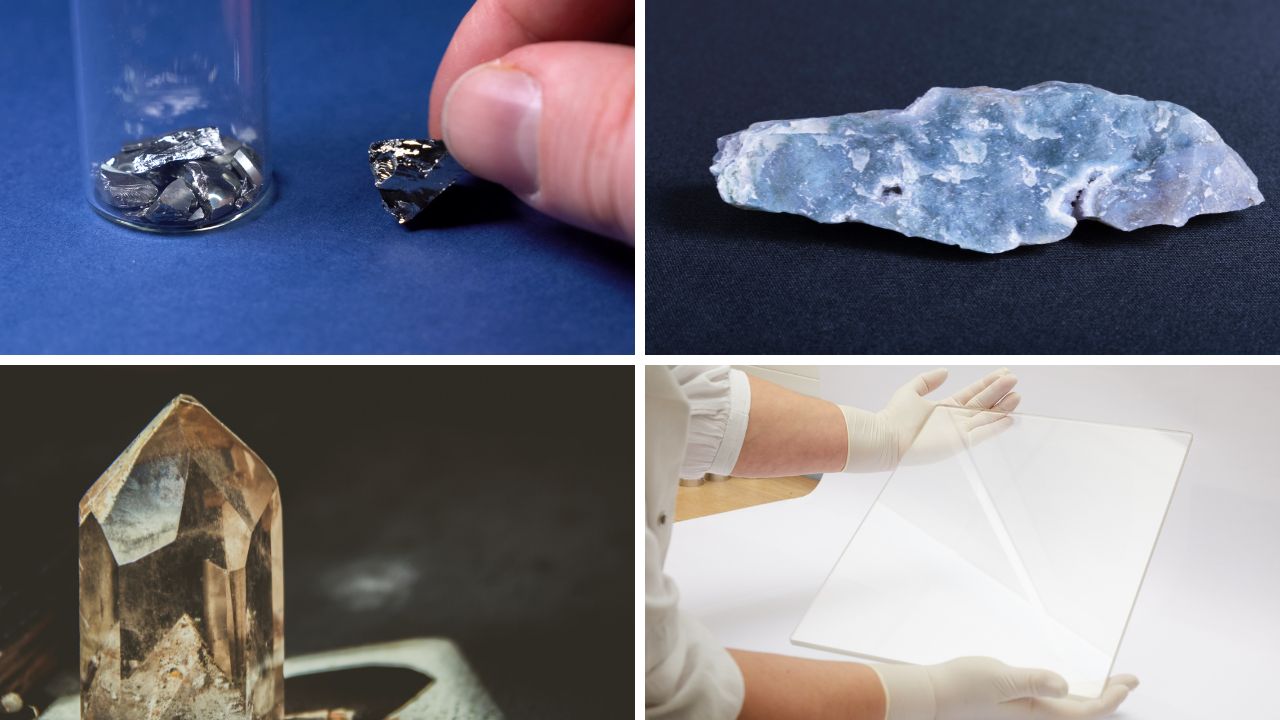
Quartz windows for versatile UV and visible applications
Quartz is a material used to manufacture optical windows dedicated to spectroscopy (sample analysis, material characterization) and laser optics (high-power laser systems). Quartz optical windows are also found in imaging systems (transparency in the visible and ultraviolet range). Quartz is used as a substrate for the manufacture of optoelectronic devices. In the field of research, quartz optical windows are used in remote sensing instruments (study of the earth’s surface, monitoring of natural resources, etc.) and telescopes for observation in the UV and visible waves. They are also used in microscopy and materials science (study of optical and electronic properties). Finally, quartz is also used as a high temperature viewing window in furnaces.
BaF2 windows for industrial infrared detection and UV and visible research
In industry, BaF2 optical windows are commonly used in infrared spectrometers, laser optics (resistance to high levels of laser energy and rapid temperature variations), thermal imaging cameras, and infrared imaging systems. For research applications, BaF2 optical portholes are used for the construction of telescopes (UV and visible observation), spectroscopy and microscopy instruments (UV and visible). In materials science, BaF2 optical windows are also used to study optical and electronic properties.
CaF2 windows for multispectral applications
CaF2 optical windows have the ability to transmit light over a wide range of wavelengths, from ultraviolet to infrared (8μm). In the industrial field, they are used in microlithography, pyrometry, UV spectroscopy (chemical industry, pharmaceutical research, etc.) and high-power UV laser optics (engraving, cutting and micromachining) as an output window. For research applications in the ultraviolet and infrared, CaF2 optical portholes are used in telescopes (far UV), microscopes (high-resolution imaging in biology and nanotechnology, UV fluorescence microscopes), Raman spectrometers and wind tunnels. It is very interesting for its high transmission over a very wide band from UV, visible to IR.
Sapphire windows for applications in harsh UV and IR environments
Due to its optical and mechanical properties, synthetic sapphire makes it possible to manufacture optical windows of very high quality. Sapphire is used for high-precision optics (spectrometers, atomic force microscopes or dimensional measurement systems) and surveillance and imaging optics (aerial, maritime and terrestrial surveillance). Sapphire windows are used as an output window for high-power lasers in particular. Highly resistant, sapphire optical windows allow applications in harsh environments (high temperatures or pressures, corrosive chemical environment, resistance to space radiation and extreme space conditions). Sapphire is also present in thermal imaging cameras to protect the optical lens while allowing the passage of infrared radiation.
Read our article on the properties and benefits of sapphire optical windows.
The manufacture of optical windows requires the selection of the right material for the desired use. Optical materials have specific characteristics identified according to criteria such as transmission spectral range, refractive index or Knoop hardness. These criteria help to define the field(s) of application where optical materials perform best. We offer you an overview of the most common areas of application of optical windows depending on the material of manufacture.
- Versatility of N-BK7 optical windows
- Pyrex optical windows for high-temperature, high-pressure observations
- Germanium optical windows for infrared applications
- ZnSe windows for high-power laser optics
- Multispectral ZnS Windows
- Silica Windows for UV and Visible Research
- Quartz windows for versatile UV and visible applications
- BaF2 windows for industrial infrared detection and UV and visible research
- CaF2 windows for multispectral applications
- Sapphire windows for applications in harsh UV and IR environments
Versatility of N-BK7 optical windows
The N-BK7 is used by industry for the protection of cameras and optical sensors in industrial imaging systems and optical dimensional measurement systems (inspection of components at high temperatures or in hostile environments). In research, N-BK7 is used in light microscopy, spectroscopy, and as a protective window. It can also be used to insulate a vacuum chamber. The N-BK7 optical windows are also suitable for use in laser research laboratories and can be used in astronomical instruments to protect optical components (telescopes, cameras).
Pyrex optical windows for high-temperature, high-pressure observations
Pyrex optical windows are often used for industrial furnaces or heat treatment equipment (high-temperature observation). They are also used to monitor chemical reactions in high-temperature, high-pressure reactors. Pyrex optical windows are also used to observe deposition processes in the coatings and vacuum metallization industry. In scientific research, they are used in fluorescence microscopes, chemical research reactors and are used in high-temperature spectrometry instruments. Pyrex windows allow observation of samples under high pressure conditions. Pyrex is used mainly in the visible range.
Germanium optical windows for infrared applications
Due to its wide spectral range in the infrared, germanium is used for the manufacture of optical windows for thermal cameras, night vision and ranging systems (security, military industry). In the field of research, germanium windows are suitable for infrared applications in spectroscopy (study of spectral properties), microscopy (high-resolution imaging of analyzed samples) and astronomy (observation of infrared emissions from stars and planets). Due to the very high reflection loss of this material, it must always be coated with an anti-reflective and/or hard carbon coating (outdoor applications).
ZnSe windows for high-power laser optics
Zinc selenide (ZnSe) optical windows are suitable for infrared optics (short and long waves). ZnSe optical windows are commonly used in high-power laser systems (cutting, welding, laser engraving). Their infrared properties are exploited for applications in thermal imaging (detecting temperature variations), spectroscopy (analysis of infrared spectra of samples), astronomy and astrophysics (on camera detectors to conduct observations). In the defense sector, ZnSe optical windows are equipped with night vision systems, infrared sights and ranging systems.
Multispectral ZnS Windows
Multispectral ZnS optical windows are used in multispectral imaging systems applied to areas such as environmental monitoring (remote sensing instruments), geological mapping or material characterization (property study). Multispectral ZnS portholes are used in spectroscopy and microscopy for sample analysis or biomarker detection. In astronomy, multispectral ZnS optical windows are integrated into the construction of telescopes.
Silica Windows for UV and Visible Research
Fused silica windows are used in imaging systems (including cameras and microscopes) and for the creation of high-quality images in the medical field or machine vision (transmission of visible light). In the fields of analytical chemistry or pharmaceutical research, they are used in spectrometers. Silica optical windows can also be mounted on laser systems (outlet windows). Scientific applications include astronomy (silica optical windows for telescope construction – ultraviolet and visible observation), biology (microscopy), materials science research (study of optical properties).

Quartz windows for versatile UV and visible applications
Quartz is a material used to manufacture optical windows dedicated to spectroscopy (sample analysis, material characterization) and laser optics (high-power laser systems). Quartz optical windows are also found in imaging systems (transparency in the visible and ultraviolet range). Quartz is used as a substrate for the manufacture of optoelectronic devices. In the field of research, quartz optical windows are used in remote sensing instruments (study of the earth’s surface, monitoring of natural resources, etc.) and telescopes for observation in the UV and visible waves. They are also used in microscopy and materials science (study of optical and electronic properties). Finally, quartz is also used as a high temperature viewing window in furnaces.
BaF2 windows for industrial infrared detection and UV and visible research
In industry, BaF2 optical windows are commonly used in infrared spectrometers, laser optics (resistance to high levels of laser energy and rapid temperature variations), thermal imaging cameras, and infrared imaging systems. For research applications, BaF2 optical portholes are used for the construction of telescopes (UV and visible observation), spectroscopy and microscopy instruments (UV and visible). In materials science, BaF2 optical windows are also used to study optical and electronic properties.
CaF2 windows for multispectral applications
CaF2 optical windows have the ability to transmit light over a wide range of wavelengths, from ultraviolet to infrared (8μm). In the industrial field, they are used in microlithography, pyrometry, UV spectroscopy (chemical industry, pharmaceutical research, etc.) and high-power UV laser optics (engraving, cutting and micromachining) as an output window. For research applications in the ultraviolet and infrared, CaF2 optical portholes are used in telescopes (far UV), microscopes (high-resolution imaging in biology and nanotechnology, UV fluorescence microscopes), Raman spectrometers and wind tunnels. It is very interesting for its high transmission over a very wide band from UV, visible to IR.
Sapphire windows for applications in harsh UV and IR environments
Due to its optical and mechanical properties, synthetic sapphire makes it possible to manufacture optical windows of very high quality. Sapphire is used for high-precision optics (spectrometers, atomic force microscopes or dimensional measurement systems) and surveillance and imaging optics (aerial, maritime and terrestrial surveillance). Sapphire windows are used as an output window for high-power lasers in particular. Highly resistant, sapphire optical windows allow applications in harsh environments (high temperatures or pressures, corrosive chemical environment, resistance to space radiation and extreme space conditions). Sapphire is also present in thermal imaging cameras to protect the optical lens while allowing the passage of infrared radiation.
Read our article on the properties and benefits of sapphire optical windows.

